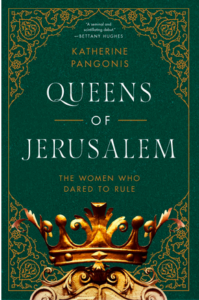By Dorothea Shefer-Vanson

MEVASSERET ZION, Israel — Author Katherine Pangonis notes in her preface to “Queens of Jerusalem: The Women Who Dared to Rule” that “this is a book about women and power.” The wives and daughters of crusader kings and princes in the Holy Land sometimes found themselves in the position of default ruler upon the death of the husband or father who had been killed in battle or fallen victim to one or another of the diseases that were rife in the region in the period when the Crusaders ruled. The author states explicitly that since the record has in the main been written by male historians, the role of women has been neglected, and she regards it as her mission to rectify this omission.
 The role of women in European monarchies was to serve essentially as brood mares, providing sons to inherit their father’s mantle as ruler, as well as consolidating their husband’s wealth and power by bringing a rich dowry into the marriage. In the case of Baldwin and Morphia the absence of a son and heir meant that the succession would pass to Melisende and through her to her husband, Fulk of Anjou. In 1131 Baldwin died and was succeeded by Melisende and Fulk, acting as regents for their child Baldwin. In 1143 Fulk fell in battle, leaving Melisende as sole ruler and regent for her 13-year-old son. From then until her death in 1181 Melisende ruled the Kingdom of Jerusalem, either directly or indirectly, managing the affairs of the monarchy, repressing rebellions by other rulers such as that of her sister, Alice who had married Raymond of Antioch and succeeded him after his death. Cities such as Acre, Tiberias and Tripoli had their own regional monarchies, and the rivalry between them often ended in military clashes. It was customary for defeated rulers to be executed or imprisoned for long periods, often in terrible conditions, until they could be ransomed, and it was often their wives or daughters who raised the funds to redeem them. This was the case with Eleanor of Aquitaine, who travelled the length and breadth of Europe to raise the ransom for the son she had borne to her second husband, Henry Plantagenet of England (Henry II), and who was known as Richard the Lionheart.
The role of women in European monarchies was to serve essentially as brood mares, providing sons to inherit their father’s mantle as ruler, as well as consolidating their husband’s wealth and power by bringing a rich dowry into the marriage. In the case of Baldwin and Morphia the absence of a son and heir meant that the succession would pass to Melisende and through her to her husband, Fulk of Anjou. In 1131 Baldwin died and was succeeded by Melisende and Fulk, acting as regents for their child Baldwin. In 1143 Fulk fell in battle, leaving Melisende as sole ruler and regent for her 13-year-old son. From then until her death in 1181 Melisende ruled the Kingdom of Jerusalem, either directly or indirectly, managing the affairs of the monarchy, repressing rebellions by other rulers such as that of her sister, Alice who had married Raymond of Antioch and succeeded him after his death. Cities such as Acre, Tiberias and Tripoli had their own regional monarchies, and the rivalry between them often ended in military clashes. It was customary for defeated rulers to be executed or imprisoned for long periods, often in terrible conditions, until they could be ransomed, and it was often their wives or daughters who raised the funds to redeem them. This was the case with Eleanor of Aquitaine, who travelled the length and breadth of Europe to raise the ransom for the son she had borne to her second husband, Henry Plantagenet of England (Henry II), and who was known as Richard the Lionheart.Melisende’s son was eventually crowned king Baldwin III, and his son and grandson eventually became Baldwin IV and Baldwin V of Jerusalem. Her second son, Amalric, married Agnes of Courtenay, and their son, Baldwin IV, died young, leaving the throne to his sister, Sybilla of Jerusalem, who first married William ‘Longsword’ of Montferrat and then Guy de Lusignan. At her marriage ceremony Sybilla ceded her power to her husband, and although they succeeded in defeating the rebellion raised against them by Raymond of Tiberias, this eventually brought about the Crusader kingdom’s downfall, as Raymond allied with the forces of Saladin, allowing them to march through his territory in what eventually led to the crucial Crusader defeat at the battle of Hattin on July 4, 1187.
Saladin succeeded in routing what remained of the Christian forces, retaking Jerusalem and all the other Crusader strongholds. The fortresses and castles the Crusaders had built throughout the Holy Land were all destroyed, though the ruins of many of them still remain as mute reminders of the forces that once ruled the land. Place names such as Beaufort and Castel preserve their memory, as do the contemporary chronicles written in Latin by William of Tyre and in Arabic by Ibn Al-Athir, on which the author based her research.
Dorothea Shefer-Vanson is an author and freelance writer who resides in the Jerusalem suburb of Mevasseret Zion, Israel. She may be contacted via dorothea.shefer@sdjewishworld.com